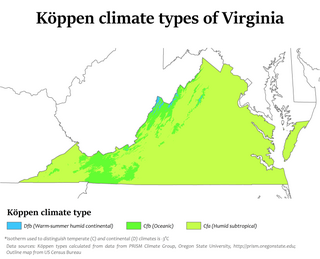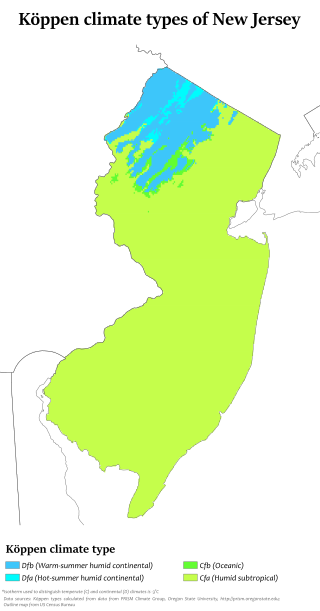
North Carolina's climate varies from the Atlantic coast in the east to the Appalachian Mountain range in the west. The mountains often act as a "shield", blocking low temperatures and storms from the Midwest from entering the Piedmont of North Carolina.

Climate change has led to the United States warming by 2.6 °F since 1970. The climate of the United States is shifting in ways that are widespread and varied between regions. From 2010 to 2019, the United States experienced its hottest decade on record. Extreme weather events, invasive species, floods and droughts are increasing. Climate change's impacts on tropical cyclones and sea level rise also affects regions of the country.
The effects of climate change in Florida are attributable to man-made increases in atmospheric carbon dioxide. Floridians are experiencing increased flooding due to sea level rise, and are concerned about the possibility of more frequent or more intense hurricanes.

The effects of climate change on small island countries are impacting people who live in coastal areas through sea level rise, increasing heavy rain events, tropical cyclones and storm surges. The effects of climate change threaten the existence of many island countries, island peoples and their cultures, and will alter their ecosystems and natural environments. Despite their heterogeneity, small island developing states (SIDS) are recognized as being particularly at risk to climate change. They share numerous common traits and have been quite vocal in calling attention to the challenges they face from climate change.

The New York Harbor Storm-Surge Barrier is a proposed flood barrier system to protect the New York-New Jersey Harbor Estuary from storm surges. The proposed system would consist of one barrier located across the mouth of Lower New York Bay, possibly between Sandy Hook (N.J.) and Rockaway (N.Y.), and a second on the upper East River to provide a ring of protection to most of the bi-state region. Through extensive use of floodgates, both barriers would have largely open cross-sections during normal conditions to minimize environmental impacts on the estuary and port operations.

Climate change in Connecticut encompasses the effects of climate change, attributed to man-made increases in atmospheric carbon dioxide, in the U.S. state of Connecticut.

Climate change in Delaware encompasses the effects of climate change, attributed to man-made increases in atmospheric carbon dioxide, in the U.S. state of Delaware.

Climate change in Georgia encompasses the effects of climate change, attributed to man-made increases in atmospheric carbon dioxide, in the U.S. state of Georgia.

Climate change in Louisiana encompasses the effects of climate change, attributed to man-made increases in atmospheric carbon dioxide, in the U.S. state of Louisiana.

Climate change in Maryland encompasses the effects of climate change, attributed to man-made increases in atmospheric carbon dioxide, in the U.S. state of Maryland.

Climate change in Mississippi encompasses the effects of climate change, attributed to man-made increases in atmospheric carbon dioxide, in the U.S. state of Mississippi.

Climate change in New Hampshire encompasses the effects of climate change, attributed to man-made increases in atmospheric carbon dioxide, in the U.S. state of New Hampshire.

Climate change in Rhode Island encompasses the effects of climate change, attributed to man-made increases in atmospheric carbon dioxide, in the U.S. state of Rhode Island.

Climate change in South Carolina encompasses the effects of climate change, attributed to man-made increases in atmospheric carbon dioxide, in the U.S. state of South Carolina.

Climate change in Virginia encompasses the effects of climate change, attributed to man-made increases in atmospheric carbon dioxide, in the U.S. state of Virginia.

Climate change in New York encompasses the effects of climate change, attributed to man-made increases in atmospheric greenhouse gases, in the U.S. state of New York. It is of concern due to its impact on the people, ecosystem, and economy of the state. Many parts of the state are already experiencing weather changes, and sea-level rise, and threatening local communities.

Climate change in New Jersey is of concern due to its effects on the ecosystem, economy, infrastructure, and people of the U.S. state of New Jersey. According to climatology research by the U.S. National Oceanic and Atmospheric Administration, New Jersey has been the fastest-warming state by average air temperature over a 100-year period beginning in the early 20th century, related to global warming.

Sinking cities are urban environments that are in danger of disappearing due to their rapidly changing landscapes. The largest contributors to these cities becoming unlivable are the combined effects of climate change, land subsidence, and accelerated urbanization. Many of the world's largest and most rapidly growing cities are located along rivers and coasts, exposing them to natural disasters. As countries continue to invest people, assets, and infrastructure into these cities, the loss potential in these areas also increases. Sinking cities must overcome substantial barriers to properly prepare for today's dynamic environmental climate.

The climate in Texas is changing partially due to global warming and rising trends in greenhouse gas emissions. As of 2016, most area of Texas had already warmed by 1.5 °F (0.83 °C) since the previous century because of greenhouse gas emissions by the United States and other countries. Texas is expected to experience a wide range of environmental impacts from climate change in the United States, including rising sea levels, more frequent extreme weather events, and increasing pressure on water resources.

Climate change in Pennsylvania encompasses the effects of climate change, attributed to man-made increases in atmospheric carbon dioxide, in the U.S. state of Pennsylvania.




























